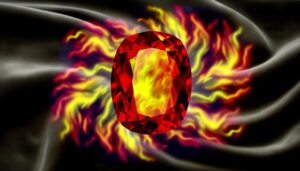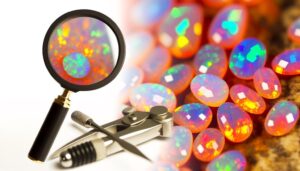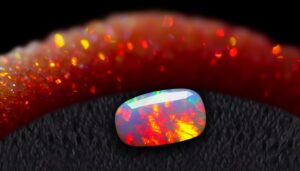How Much Do Fire Opal Prices Vary?
Fire opal prices vary greatly, depending on factors like color intensity, clarity, cut, carat weight, and origin. Strong red or orange hues command higher prices.
Transparent fire opals without inclusions are more valuable. Precision in cut and shape enhances sparkle and affects value.
Carat weight plays a role, with larger stones fetching more. Origin, such as Mexican versus Ethiopian opals, also influences price.
Treatments like heat or dyeing can impact value negatively. Understanding these factors can help you make an informed purchase and get the best value.
Continue to explore specific tips for identifying and buying fire opals.
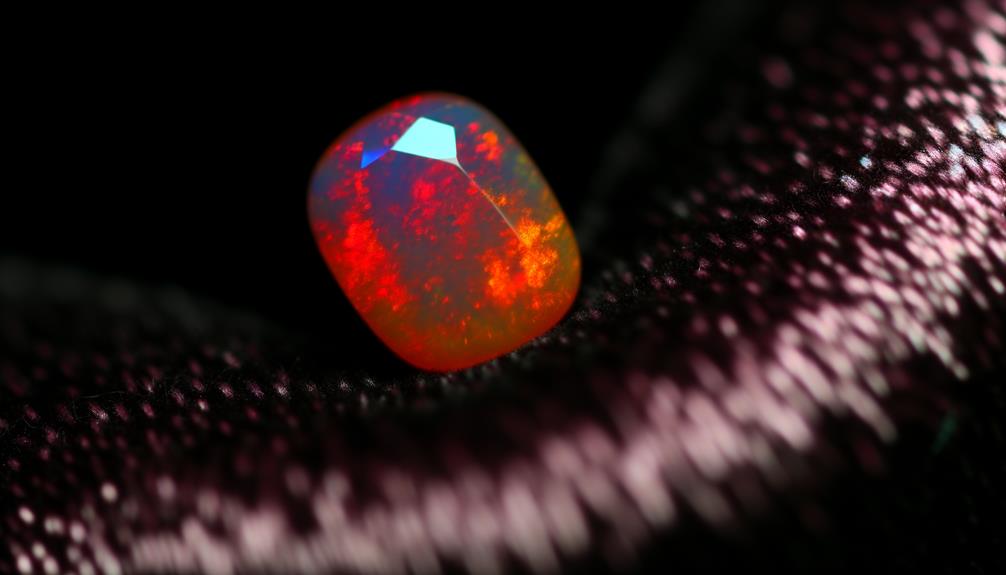
Key Takeaways
- Fire opal prices range from $10 to $500 per carat depending on color, clarity, cut, and origin.
- Red to orange hues are most valuable, often fetching higher prices.
- Mexican fire opals are generally more sought after and can be more expensive.
- Enhanced and treated opals are typically less valuable than natural, untreated ones.
- Carat weight significantly influences price; larger fire opals command higher prices per carat.
Understanding Fire Opal Value
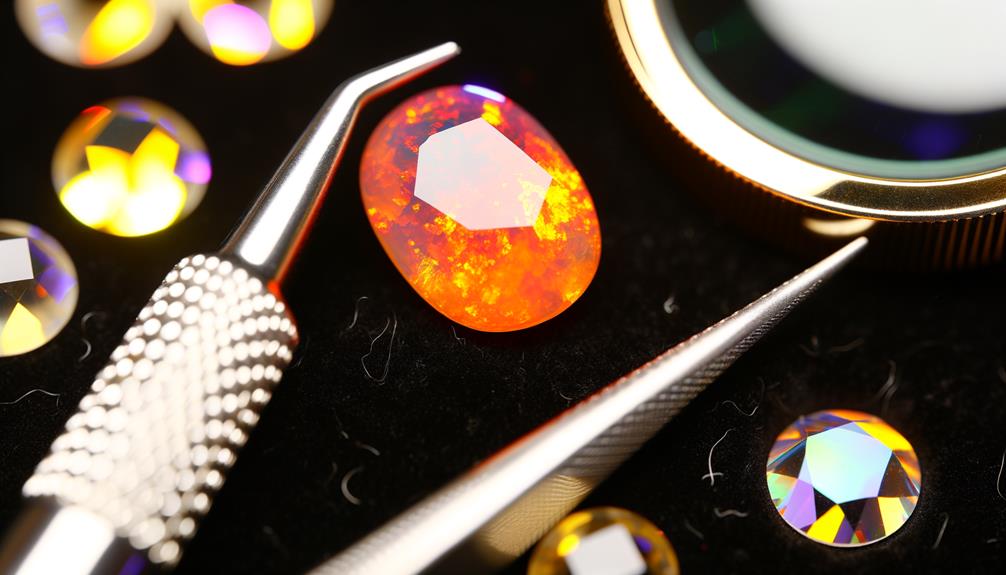
To understand fire opal value, you need to take into account factors such as color, clarity, cut, and carat weight.
Color is paramount; the most prized fire opals exhibit a vivid, fiery hue ranging from red to orange.
Clarity involves gauging the transparency and absence of inclusions, with clear stones being more valuable.
The cut affects how well the gem reflects light, enhancing its brilliance. A precise, well-executed cut can greatly enhance a fire opal's appeal.
Finally, carat weight measures the stone's size, with larger opals generally commanding higher values.
Factors Affecting Price
When determining the price of fire opals, various factors such as market demand, origin, and treatment greatly influence their value. Market demand can fluctuate, impacting price based on rarity and current trends.
Origin also matters; Mexican fire opals, for example, often command higher prices due to their renowned quality. Treatments, including enhancements or synthetic processes, can greatly affect value. Untreated, natural fire opals are generally more valuable than treated ones.
Clarity and transparency play essential roles as well; fewer inclusions and higher transparency usually lead to higher prices. Size is another critical factor; larger fire opals are rarer and thus more expensive. Each of these elements must be considered when evaluating the worth of a fire opal.
Color Intensity

When evaluating fire opals, you'll need to assess the vibrancy and hue, as these directly impact value.
Analyze whether the stone exhibits light or dark tones, as this can affect its market appeal.
Additionally, pay attention to color distribution patterns, which play an essential role in determining overall quality.
Vibrancy and Hue
Evaluating the vibrancy and hue of fire opals involves examining the stone's color intensity and how it impacts overall value.
You'll need to assess the saturation, which refers to the purity and vividness of the color. High saturation in fire opals often correlates with a higher market value.
Additionally, consider the hue, which is the basic color of the stone. Fire opals range from yellow to deep red, with red and orange hues typically being more prized.
Uniformity of color distribution across the stone also plays an essential role. Stones with consistent, intense coloration are more desirable.
Light Vs. Dark
When evaluating fire opals, the intensity of color, whether light or dark, greatly influences their value and appeal. You'll find that darker fire opals often command higher prices due to their vivid, striking hues. Conversely, lighter fire opals, though still beautiful, may be valued less due to their subtler tones.
To help you understand the factors that affect fire opal value based on color intensity, consider the following points:
- Darker hues: Typically richer, deeper colors.
- Lighter hues: Generally softer, more pastel tones.
- Market demand: Darker opals are often more sought after.
- Visual appeal: Darker fire opals tend to stand out more, enhancing their desirability.
Understanding these elements will help you make informed decisions when evaluating fire opals.
Color Distribution Patterns
Color distribution patterns in fire opals play a crucial role in determining their overall intensity and market value. You need to assess how evenly the color spreads across the stone. Uniformly distributed, vibrant hues significantly enhance the opal's appeal.
Conversely, patchy or uneven color zones can diminish its worth. Evaluate the saturation of the color; higher saturation often translates to greater value. Don't overlook the interplay of colors; a harmonious blend can uplift the stone's desirability.
Also, you should consider the impact of light; certain patterns reveal their beauty only under specific lighting conditions. By understanding these factors, you'll be better equipped to judge a fire opal's true market value and make informed purchasing decisions.
Clarity and Transparency
Despite its vibrant hues, the clarity and transparency of fire opal greatly influence its value and desirability. You should consider these factors analytically:
- Clarity: High clarity fire opals, free of inclusions or fractures, are more valuable. Inclusions can disrupt light passage, diminishing brilliance.
- Transparency: Transparent fire opals are typically more desirable. They allow light to pass through easily, enhancing the gem's play-of-color.
- Inclusions: Visible inclusions or cloudiness lower the opal's value. Tiny particles or cracks can interfere with the opal's visual appeal.
- Assessment: Examine under various light conditions. Use a 10x loupe to inspect for internal flaws, ensuring an accurate assessment of clarity and transparency.
Understanding these elements helps you evaluate fire opal value more precisely.
Cut and Shape

In evaluating fire opals, the cut and shape play an important role in maximizing their visual appeal and overall value. A well-executed cut enhances the stone's color play and brilliance, vital for fire opals. Precision in cutting guarantees that light interacts optimally within the stone, highlighting its unique fire.
Shapes like oval, round, and pear are common, each influencing how light disperses. Cabochon cuts, frequently used for fire opals, enhance the stone's depth and color play, making them more desirable. Symmetry and proportions are essential; an asymmetrical or poorly proportioned cut can greatly reduce the stone's value.
Always evaluate the craftsmanship of the cut and the chosen shape to make sure the fire opal's beauty and worth are fully realized.
Carat Weight
When evaluating fire opals, carat weight greatly influences both the price and the perceived value of the stone. Larger carat weights tend to command higher prices due to their rarity and the increased difficulty in finding larger, high-quality stones.
As you assess fire opals, consider these key points:
- Price Per Carat: Typically, the price per carat increases with larger stones because they're less common.
- Market Demand: Larger fire opals are often more sought after, driving up their market value.
- Cut Efficiency: Heavier stones might result in more waste during cutting, impacting final pricing.
- Visual Impact: Larger carat weights offer a more striking visual presence, enhancing their desirability.
Origin and Mining Locations
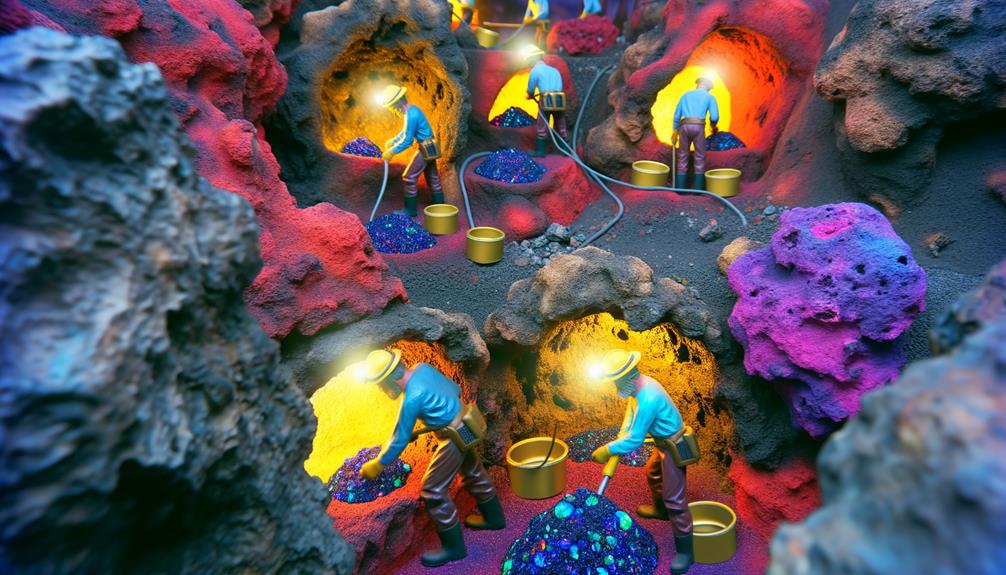
Fire opals' value is greatly influenced by their origin, with notable mining locations including Mexico, Brazil, and Ethiopia. Mexican fire opals are particularly prized for their vibrant colors and clarity, often displaying a vivid play of red and orange hues.
Brazilian fire opals usually possess a more subtle range of colors but still maintain high quality. Ethiopian fire opals, relatively new to the market, are known for their diverse color palette and striking transparency.
Each location imparts unique characteristics to the opals mined there, affecting their desirability and market value. Understanding these origins helps you appreciate the nuances in fire opal quality, assisting you in making informed decisions when purchasing or appraising these gemstones.
Market Trends
Recent shifts in supply and demand dynamics have greatly impacted the market trends for fire opals. You'll notice that these changes are driven by several key factors:
- Global Mining Output: Variations in mining activities, especially in Mexico and Ethiopia, directly influence fire opal availability.
- Consumer Preferences: Rising interest in unique, colorful gemstones has increased demand for high-quality fire opals.
- Economic Factors: Fluctuations in economic conditions affect both consumer purchasing power and investment in gemstones.
- Technological Advancements: Improvements in gemstone cutting and polishing techniques enhance fire opal aesthetics, making them more appealing to buyers.
Fire Opal Treatments
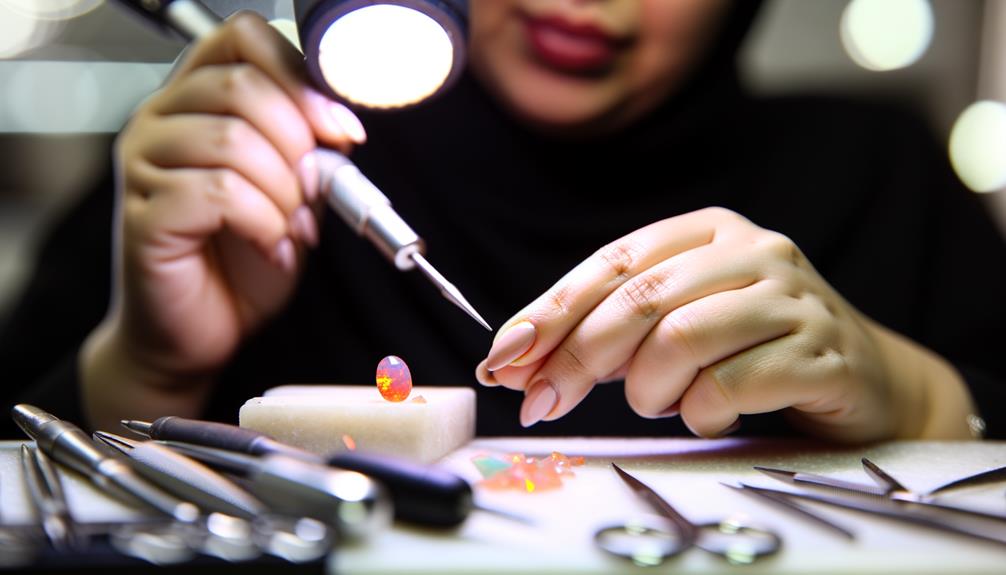
When considering fire opal treatments, you should first understand common enhancement methods such as heat treatment and resin filling. These treatments can have a notable impact on the value of the opal, either positively or negatively.
Identifying treated opals requires a keen eye and often specialized equipment to guarantee accurate assessment.
Common Enhancement Methods
Many fire opals undergo treatments to enhance their color and clarity, guaranteeing they meet market standards. Understanding these methods helps you appreciate their impact on the gem's appearance.
Common enhancement techniques include:
- Heat Treatment: This method enhances color intensity and uniformity.
- Dyeing: Used to improve or alter the stone's original color, though less common for fire opals.
- Impregnation: Involves filling voids with substances like resin to enhance durability and appearance.
- Oil Treatment: Oils or waxes are applied to boost the stone's luster and conceal minor imperfections.
These methods are standard in the industry, and being aware of them assures you can make an informed decision when purchasing fire opals.
Treatment Impact on Value
Understanding how various treatments affect the value of fire opals is essential for making informed purchasing decisions. Treatment methods such as dyeing, impregnation with resins, or heat treatment can greatly impact the gemstone's worth. Untreated fire opals typically command higher prices due to their natural beauty and rarity.
Enhanced stones, while often visually appealing, usually sell for less due to their altered nature. Resin-impregnated opals, for instance, may offer increased durability but are less valuable than their untreated counterparts. Heat treatment can enhance color but may also reduce the stone's structural integrity.
To maximize investment, prioritize untreated fire opals, recognizing that treatments generally decrease overall value despite potential improvements in appearance and durability.
Identifying Treated Opals
To accurately assess a fire opal's value, you must be adept at identifying common treatments such as dyeing, resin impregnation, and heat treatment. These methods can notably alter the opal's appearance and, consequently, its worth. Here's how you can identify them:
- Dyeing: Look for unnatural color concentrations or an even color distribution, which is rare in natural opals.
- Resin Impregnation: Check for an overly glossy finish or a plastic-like feel, indicating resin use.
- Heat Treatment: Observe any enhanced transparency or intensified color, which might suggest heat alteration.
- Fracture Filling: Inspect for visible lines or patterns within the opal, indicating filled fractures.
Understanding these treatments helps you make informed evaluations and purchase decisions.
Buying Tips and Considerations
When considering the purchase of a fire opal, scrutinize the stone's color, clarity, cut, and carat weight to determine its true value.
A vivid, consistent color indicates high quality and desirability. Examine the stone under different lighting conditions to assess its clarity; inclusions can greatly impact value.
The cut should enhance the stone's natural brilliance, maximizing light reflection. Evaluate the carat weight in relation to the stone's dimensions; larger stones are rarer and hence more valuable.
Additionally, request certification from a reputable gemological laboratory to authenticate the opal's origin and treatment status.
Always compare multiple stones and consult with knowledgeable gemologists to make an informed decision and obtain the best value for your investment.
Conclusion
To sum up, comprehending fire opal's worth demands a close examination of color intensity, clarity, cut, and origin.
Remember, not all that sparkles is gold; the opal's true value lies in its distinctive characteristics and market trends.
Always be cautious of treatments and authenticity when making a purchase.
By evaluating these factors critically, you can make informed choices and invest wisely in this enchanting gemstone.


